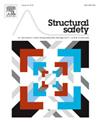基于高斯过程分类器和随机集理论的主动学习仿真故障集估计
IF 6.3
1区 工程技术
Q1 ENGINEERING, CIVIL
引用次数: 0
摘要
广泛的工业应用需要跨各种输入集进行大量耗时的模拟,例如优化,校准或可靠性评估。在这种情况下,可以观察到一些模拟失败或不稳定性,例如,由于复杂偏导数方程数值格式的收敛问题。大多数情况下,与失败相对应的输入集是未知的,因此可能与隐藏的约束相关联。由于观察关于这个未知约束的模拟失败可能与可行的昂贵模拟一样昂贵,因此在进一步分析之前,我们寻求学习可行的输入集,从而学习没有模拟失败的目标区域。在这种分类背景下,我们提出了一种新的自适应高斯过程分类器来学习可行域。所提出的方法是使用随机集范式和高斯过程分类器逐步减少不确定性的批处理模式主动学习分类策略。该策略的性能在几个隐藏约束问题上得到了验证,特别是在基于风力发电机模拟器的可靠性分析的背景下。本文章由计算机程序翻译,如有差异,请以英文原文为准。
Estimation of simulation failure set with active learning based on Gaussian Process classifiers and random set theory
A wide range of industrial applications require numerous time-consuming simulations across various input sets, such as for optimization, calibration, or reliability assessments. In that context, some simulation failures or instabilities can be observed, due for instance, to convergence issues of the numerical scheme of complex partial derivative equations. Most of the time, the set of inputs corresponding to failures is not known a priori and thus may be associated to a hidden constraint. Since the observation of a simulation failure regarding this unknown constraint may be as costly as a feasible expensive simulation, we seek to learn the feasible set of inputs and thus target areas without simulation failure before further analysis. In this classification context, we propose to learn the feasible domain with a new adaptive Gaussian Process Classifier. The proposed methodology is a batch-mode active learning classification strategy that reduces uncertainty step by step, using a random set paradigm and a Gaussian Process Classifiers. The performance of this strategy is demonstrated on several hidden-constrained problems, particularly in the context of a wind turbine simulator-based reliability analysis.
求助全文
通过发布文献求助,成功后即可免费获取论文全文。
去求助
来源期刊

Structural Safety
工程技术-工程:土木
CiteScore
11.30
自引率
8.60%
发文量
67
审稿时长
53 days
期刊介绍:
Structural Safety is an international journal devoted to integrated risk assessment for a wide range of constructed facilities such as buildings, bridges, earth structures, offshore facilities, dams, lifelines and nuclear structural systems. Its purpose is to foster communication about risk and reliability among technical disciplines involved in design and construction, and to enhance the use of risk management in the constructed environment
 求助内容:
求助内容: 应助结果提醒方式:
应助结果提醒方式:


